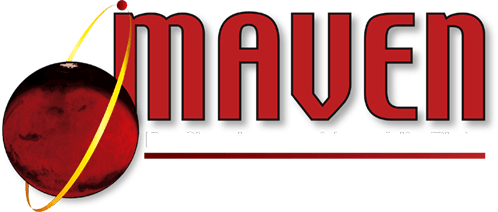Below is a guide to notable research from NASA’s Mars Atmosphere and Volatile Evolution (MAVEN) mission being presented at the hybrid Dec. 12-16 American Geophysical Union 2022 meeting. Presentations are listed in chronological order, and all times are CST.
Media contacts: Willow Reed, willow.reed@lasp.colorado.edu

Characterizing Energy Spectra of Precipitating Solar Wind H+ and H– in the Martian Atmosphere
Sarah Henderson, University of Iowa
Henderson is seeking to characterize the spectra of hydrogen ions (H+ and H–) to better understand how hydrogen energetic neutral atoms interact with neutrals in the Martian atmosphere. The results have led to Henderson’s group seeing interesting and unexpected behaviors during Mars’ “dust-storm season.”
Tues Dec. 13, 14:45-18:15 | McCormick Place – Poster Hall, Hall A (South, Level 3) | P25E-2144
A Statistical Study of the Martian Ionopause and Comparisons with Venus
Zachary Girazian, University of Iowa
Although some characteristics of the ionopause—the upper edge of the ionosphere—of Mars have been studied using data from the MAVEN mission, a complete statistical analysis of ionopause observations has not yet been conducted. Girazian will present the results of a statistical study of the ionopause using seven years of MAVEN data and compare ionopause characteristics at Mars with those at Venus.
Tues Dec. 13, 14:45-18:15 | McCormick Place – Poster Hall, Hall A (South, Level 3) | P25E-2151
On the Relationship Between Discrete Aurora and Magnetic Reconnection at Mars from MAVEN Observations
Charles Bowers, University of Michigan Ann Arbor
The exact mechanisms that generate auroral electrons—accelerated precipitating electrons that travel along open magnetic field lines and collide with the atmosphere—remain unknown. Bowers has related discrete aurorae at Mars, formed via auroral electrons, to magnetic reconnection for the first time, giving us further insight into auroras on Mars.
Wed Dec. 14, 09:00-12:30 | McCormick Place – Poster Hall, Digital Poster Monitor Zone 4| SM32A-72
A Systematic Comparison of the Magnetic Field Distributions of Mars and Venus Under Similar Upstream Conditions
Josephine Johnson, Laboratory for Atmospheric and Space Physics
Unlike Earth, Mars and Venus both lack a global intrinsic magnetosphere; instead, the planets’ ionospheres interact with the solar wind to create induced magnetospheres that remain to be understood. Using magnetometer data from MAVEN and the Venus Express (VEX) missions, Johnson found important differences between Mars’ and Venus’ magnetic field structures. These differences, including asymmetries and the relative sizes of the magnetospheres, provide insight into the characteristics that shape induced magnetospheres.
Wed Dec. 14, 09:00-12:30 | McCormick Place – Poster Hall, Digital Poster Monitor Zone 4| SM32A-74
HCO+ Dissociative Recombination and Other Significant Drivers of Nonthermal Hydrogen Loss at Mars
Bethan Gregory, Laboratory for Atmospheric and Space Physics
Using a computer model, Gregory discovered a previously unconsidered process that could be causing a significant amount of hydrogen loss from Mars. This process is also likely to be important on Venus and some exoplanets.
Wed Dec. 14, 15:17-15:27 | McCormick Place – S404ab (South, Level 4) | P35A-04
Impacts of Frequent Solar Flares on the Atmospheric Escape at Mars
Yuni Lee, NASA Goddard Space Flight Center, University of Maryland Baltimore County
Solar flares bring interesting phenomena to Mars whose atmosphere directly interacts with the solar wind due to the absence of an Earth-like intrinsic magnetic field. Lee reports how the frequency of flares affects the atmospheric loss process, starting with Mars. The model could also provide a framework for understanding this type of loss process on other planets.
Wed Dec. 14, 15:57-16:07 | McCormick Place – S404ab (South, Level 4) | P35A-08
Assessing the Relationship Between Extreme Space Weather, Magnetospheric Disturbances, and Proton Aurora Activity at Mars
Andréa C. G. Hughes, NASA Goddard Space Flight Center, Howard University
Hughes presents a comparative study evaluating correlations between Martian proton aurora and notable “Magnetospheric Disturbance Index” (MDI) events. These are periods of magnetospheric disturbance caused by extreme solar activity, which often also generates auroral activity at the Red Planet. The results of this study enhance our understanding of the connection between space weather, disturbances in the magnetosphere, and proton aurora. This will be even more important as solar activity increases with the approach of solar maximum.
Thurs Dec. 15, 09:00-12:30 | McCormick Place – Poster Hall, Hall A (South, Level 3) | P42E-2443
Space Weather at Mars: Monitoring and Reporting of Solar Flares Observed at Mars using the MAVEN Extreme Ultraviolet Monitor (EUVM)
Phillip C. Chamberlin, Laboratory for Atmospheric and Space Physics
The XRS instrument on the NOAA/GOES satellites provides space weather monitoring at Earth that is extremely valuable for real-time event identification and reporting. Monitoring helps protect technology, as well as identify and study solar eruptive events and their impacts. Similar to the NOAA/GOES/XRS instrument, the Extreme Ultraviolet Monitor (EUVM) on the MAVEN mission routinely monitors the Sun. In fact, MAVEN is the only asset at Mars able to observe the Sun’s activity and the response of the Martian atmosphere at the same time. Chamberlin’s poster will discuss EUVM measurements, converting EUVM measurements to GOES/XRS equivalent levels, flare detection thresholds, and updates to the EUVM processing pipeline that will allow XRS-equivalent flare detection at Mars to be reported as quickly as possible.
Thurs Dec. 15, 09:00-12:30 | McCormick Place – Poster Hall, Hall A (South, Level 3) | P42E-2444

